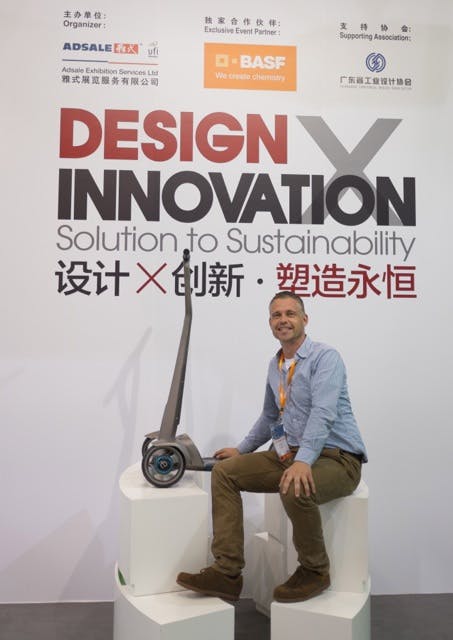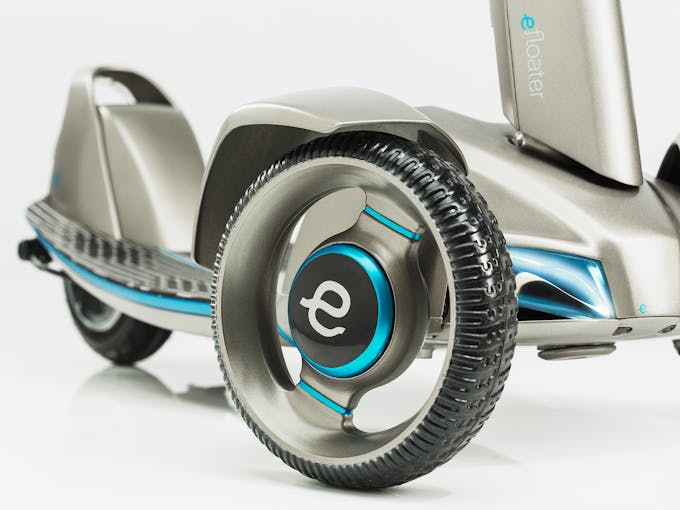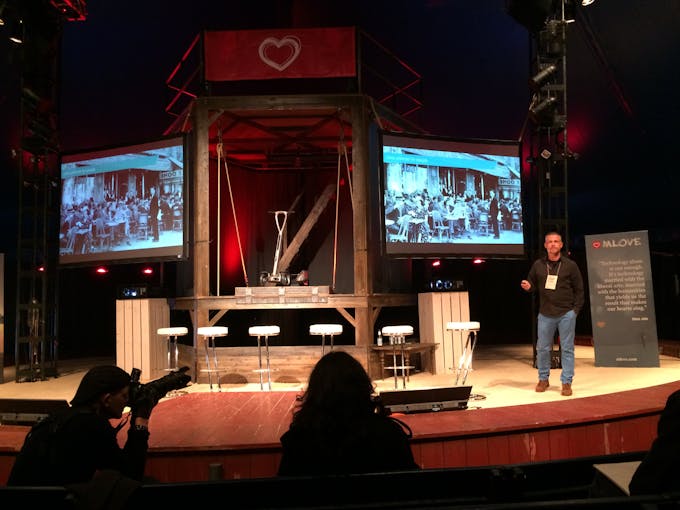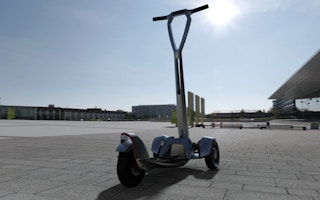Endless miles of traffic congestion, smoggy skies, and frazzled motorists are all too common in cities around the world. But while everyone agrees that these problems need to be tackled, persuading people to leave their cars behind for public transport is a separate uphill task altogether.
Often, the biggest barrier in getting commuters to choose buses and trains over their cars is what is known as the last mile: the distance between a commuter’s home or office and the nearest major transport node.
Some commuters are turning to bicycles, skateboards, and even electric kick-scooters to bridge this distance. But cycling in tropical cities is a sweat-drenched affair, and carrying scooters onto crowded trains is not only cumbersome for commuters, it can also take up valuable standing room for passengers. In fact, cities such as Singapore have banned folding bicycles on buses and trains during peak hours.
One up-and-coming start-up hoping to offer a solution that addresses these problems is Hamburg-founded, Singapore-headquartered Floatility. Its core product is a solar-powered electric scooter made from lightweight plastic, which users can access through a scheme similar to bicycle-share programmes in London, Paris, and other cities.
These sleek rides, which weigh 12 kilogrammes, are fitted with three wheels instead of the two found in most electric scooters. They promise commuters a smooth ride, easy balance, and the sensation of “floating through the city”, says Floatility’s founder and chief executive officer, Oliver Risse.
Aptly named ‘e-floaters’, the scooters are meant to be docked at stations located in public places such as housing estates and train stops, so that users can hop on one to cover the short but crucial last mile.
Each docking station will also be fitted with solar panels; this solar energy will charge the scooters, making them zero-emission vehicles. An accompanying mobile application allows users to book scooters, and enables operators of the sharing network to track their usage.
In a recent interview, Risse shares that the company has come a long way since it was incorporated in Hamburg in 2013 with funding from an angel investor in Germany and Singapore-based sustainable business accelerator OneNorth Ventures, where Risse is also a managing partner.
From lab to reality

Oliver Risse, founder and chief executive, Floatility. Image: Floatility
Taking the idea behind Floatility – which Risse calls “a disruptive take on short distance mobility” – from lab to reality involved years of rigorous designing, prototyping, and supply chain planning.
In May, the e-floaters, developed in collaboration with acclaimed German designer Sebastian Hess, were unveiled at an exhibition in Guangzhou, China. Users who have ridden one of the seven existing prototypes “have only good feedback”, says Risse.
Now, the company is poised to take its concept to the next level, with plans to conduct two simultaneous test-beds in Singapore and Germany later this year.
The first, at the Singapore University of Technology and Design (SUTD), will see up to 100 scooters rolled out at the university campus in the eastern part of Singapore.
This year-long trial has the support of Singapore’s Economic Development Board, and will involve students, staff, and researchers testing out the product and providing feedback to the company.
At the same time, Floatility will also conduct a similar trial in Hamburg to see how the scooters perform in Germany’s icy winters.
These trials will bring Floatility one step closer to its vision of making its e-floaters a ubiquitous sight in cities around the world, says Risse. Feedback from the trials will determine how much work needs to be done to improve the scooters and software before it can be commercialised.
Risse adds that since 2013, the company has also grown to a team of seven employees – four in Singapore, and three in Germany. Its progress would not have been possible without its key partners, he says.
In the initial days, it was difficult for the company to secure funding because hardware projects tend to require higher up-front investments than software ventures. To overcome this, Floatility’s management decided to search for international early stage investors right from the beginning.
“We were very happy to find funding partners who understand the space and need for a long-term view,” he says. While the exact value of the company is confidential, “Floatility has invested beyond S$1 million to get to where we are”, he adds.
The start-up also partnered with several larger companies across a range of industries to design and manufacture its unique scooter.
Success rides on good design

A close-up of the e-floater, which was designed using several software packages from Autodesk. Image: Floatility
One company whose support Floatility’s designers and engineers relied on “from day one” is American software multinational Autodesk, whose 3D modelling software is a mainstay in design and architecture laboratories around the world.
Floatility was a perfect fit for Autodesk’s Cleantech Partner Program, under which the global firm provides entrepreneurial sustainability-themed start-ups with free access to up to US$150,000 worth of digital prototyping software.
“Autodesk’s powerful software platforms helped us to streamline the design and development process between our international teams,” says Risse, who was already familiar with Autodesk software as former founder of Greenlots, an electrical vehicle charging infrastructure company from 2008 to 2012. The firm was the first Singapore company to join Autodesk’s Cleantech Partner Program in 2011.
Autodesk was intrigued by Floatility’s concept and under the Cleantech Partner Program, provided a comprehensive range of software that would allow Risse and his team to design and prepare the e-floaters for manufacture.
Key software packages that helped Floatility perfect the design of their scooters were Inventor, a professional-grade tool for 3D mechanical design and product simulation; and Alias, a set of tools which allow for modelling industrial products and mocking up how they will look.
Beyond design, Floatility’s engineers also had to ensure their products were easy to manufacture. “That was a big challenge we had,” Risse says.
Enter another Autodesk tool, ‘Fusion 360’, which allows users to test and understand whether a product design is feasible from a manufacturing perspective.
This cloud-based programme enables engineers to verify how the various components of a product can be fitted together, how moving parts will behave, and create a workflow for the object to be 3D-printed. The software also allows several engineers and designers to design the product collaboratively.
As Floatility begins manufacturing its scooters in larger batches using injection moulding - a manufacturing process that involves injecting heated plastic into special moulds to make product parts - it is also exploring how to use Autodesk’s Moldflow software, which provides tools for designing moulds and plastic parts.
This partnership shows “how a big software company can help a tiny cleantech company to develop top-of-the-line products”, says Risse.
Going forward, Floatility’s Singapore-based designers will be trained in Autodesk software so that the company can build up in-house expertise to design future scooter models, says Risse. Students at SUTD, where Floatility will be conducting its test-bed, are also well-versed in Autodesk software and will hopefully play a part in designing the next-generation vehicles, he adds.
The journey to commercialisation

Oliver Risse, founder and CEO, Floatility, talks about the Floatility concept at the MLove Confestival in Hamburg, Germany. Image: Floatility
While Autodesk’s support was crucial to getting the design and manufacturing right, other companies have also played a crucial role in getting Floatility to where it is today.
Among these are German chemicals manufacturer BASF, which is providing the lightweight plastic that makes up more than 80 per cent of each scooter; Israeli 3D printing giant Stratasys, which helped print the early prototypes; and ID-IC & Partners, a Jakarta-based company renowned for its expertise in injection moulding.
Between three and six injection-moulded scooters will be delivered to Singapore in mid-August, and if they fare well in internal trials, Floatility plans to produce up to 100 more vehicles, shares Risse.
The next few months will be an exciting flurry of trials, test-beds, and fine-tuning the concept based on feedback from participants, says Risse, who believes that the commercial opportunity for Floatility is huge.
For one thing, the shared network of e-floaters will nicely complement other last-mile mobility solutions such as bicycle-share schemes. While Floatility does not see itself as a replacement for bicycle-share programmes, its electric motors, light-weight design and foldability will set it apart from bikes, he says.
The company is exploring opportunities in Europe, where many cities are actively seeking car-less transport solutions, adds Risse, who also sees tremendous potential for Floatility in Singapore and other Asian cities.
But the concept is not without its obstacles. In Singapore, the jury is still out on whether e-scooters will be deemed safe enough by the Land Transport Authority to be used on roads and pedestrian walkways.
LTA is conducting an on-going assessment and is also keeping a close eye on Floatility’s trials, says Risse. “If they do eventually allow it, there’s a huge opportunity as e-floaters could also improve mobility and access in private estates such as large factory premises, university campuses, and tourist resorts,” he says.
Some other cities that Floatility is eyeing include Beijing, Shanghai, Bangkok, and Taipei, where bike-sharing networks already exist. In these cities, where hopping onto a shared vehicle to travel short distances is already the norm, Floatility will offer an additional, electric option for last-mile mobility.
“There is a lot of positive momentum for us right now,” says Risse. “We hope to carry it into the pilot projects, and spread the message about this great solution.”
Floatility is part of the Autodesk Cleantech Partner Program. The program supports clean technology innovators who are developing innovative solutions to solve the world’s environmental challenges. As part of the program, eligible companies receive world-class software to design, visualise, and simulate their ideas and accelerate their time to market through 3D Digital Prototyping. To apply for or learn more, visit www.autodesk.com.sg/cleantech















